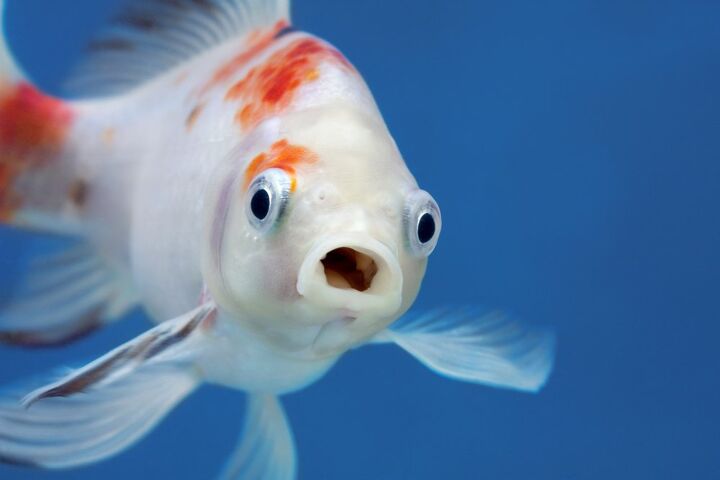How To Tell If Your Fish Are Happy

Happiness and healthiness go hand in hand, and that’s even true for fish. Everything from feeding and water clarity can affect fish mental health. Understandably, it can be hard to tell if your fish are happy.
You can tell your fish are happy if they eat right away and actively swim the length of the tank. Your fish are likely unhappy if they hide from each other and let food sit at the bottom of the tank. Keep the water clean with a pH level of 6.8-7.8 to keep your fish happy.
Too many fish crammed into a small tank can not only make them unhappy, but it can also harm them. Follow along as we explore how to tell if your fish are happy, so you can give them the best life possible.
How Do I Know If My Fish Are Happy?
Everything from eating and swimming habits to scale color can indicate if your fish are happy. The only way to know if your fish are happy is to keep a close eye on them every day. You can watch for a few key signs to tell if your fish are happy, such as:
1. Regular Eating Schedule
How often your fish eat can ultimately tell you a lot about their health and happiness. Unhappy and diseased fish are unlikely to eat regularly. For example, you can often tell something is wrong if your fish leaves food on the ground for over 10 minutes.
Dirty water and an imbalanced pH level can explain why your fish aren’t eating. Both of these factors can make fish unhappy and unhealthy. That’s why you must keep pH test strips around and change the water in the tank every 2-4 weeks.
You can tell your fish are happy if they seem excited to rush to the surface when you feed them. Otherwise, they may simply stay where they are and avoid food altogether.
2. They Are Active
Active fish are happy fish when it comes to aquariums, in most cases. Some species may prefer to hide, but many common aquarium fish like to swim around as much as possible. You can tell your fish are happy if they regularly swim throughout the whole tank.
Plants and obstacles make it easier for your fish to get active in the tank. Fake plants work as well if you don’t want to increase the light to take care of live planrs. It also helps to add caves, tunnels, and hiding spots for your fish to have fun with.
3. Healthy Breathing
It’s important to pay attention to their gills when your fish swim around. Rapid fluttering can indicate a lack of oxygen and slow fluttering can point to illness. Both irregularities can mean there is disease and unsafe conditions within the tank that make them unhappy.
Healthy fish flap their gills roughly 70-120 times per minute. Of course, that’s hard to keep track of at home, but you can get an idea of the pattern when you watch them. You can even look up videos of healthy aquariums that contain the same fish to understand the ideal breathing rate.
Install an air pump, add plants, change the water, and agitate the surface to add oxygen to the tank. A lack of oxygen can stress your fish out and ultimately kill them.
4. Their Appearance Is Vibrant
Depending on the species, most aquarium fish have a vibrant appearance. The scales and gills typically look colorful when fish are happy and healthy. Keep in mind that some fish simply change color throughout their lives.
However, it’s important to research the species of fish in your tank if you notice discoloration and white spots. It could be normal, but it could also point to malnutrition, disease, and even depression.
5. Clean Water
The clarity and cleanliness of the water in your fish tank affects everything from diet and growth to happiness. Murky, green water points to imbalances and even algae that can lower the oxygen in the tank. Water clarity is more important than nearly any other part of aquarium maintenance.
A pH level of 6.8 to 7.8 is also crucial for a healthy fish tank. This can be hard to maintain if you don’t check the pH level at least a few times per week, but it’s worth the hassle. Keep your tank as clear as possible and check to make sure it doesn’t smell bad. Otherwise, your fish may become unhappy.
6. The Tank Is Big Enough
The size of your tank relative to the population of fish has a lot to do with how happy your fish are. Overpopulated tanks can reduce the oxygen level and make your fish unhappy. Ideally, every 1-2 gallons of water should only have 1 inch of fish.
For example, a 10-gallon tank should only contain up to 8 fish at once. This gives them enough space to swim around, get active, and enjoy their lives. Otherwise, they will feel overcrowded, depressed, and more susceptible to illness.
7. They Swim Together
Unhappy fish often isolate themselves in the tank. Happy, healthy fish prefer to swim in schools, or groups, and stick together. Of course, some fish may swim alone if they are a different species than the other fish, and that’s normal.
Pay attention to the lonely fish and check to see if its body and gills show signs of stress. It’s also important to check its gill flutter rate and see if it eats regularly. Fish love to stick together when they’re happy and this keeps them active.
Are My Fish Stressed?
You can tell your fish are stressed if they swim and breathe erratically. This can point to low oxygen, illness, and parasites in extreme cases. Self-isolation can also show that they are unhappy, injured, and possibly diseased. For example, you can tell something is wrong if they quickly swim away from nearby fish.
Another key sign that your fish are stressed is if they mostly stay in one spot. This can indicate that they are unhappy and afraid or that the water conditions aren’t ideal. In that case, it’s important to clean the tank, check the temperature, and change the water as needed.
You can also tell your fish are stressed and unhappy if they swim along the length of the tank's glass. This is normal in small doses, but not if they only fixate on the glass. Also known as “glass surfacing”, it’s a sign that your fish want to get away from the stress they experience.
Summing It Up
You can tell your fish are happy if they regularly eat, stay active, and swim with the other fish. Clean water can also keep your fish happy. Signs of stress include fish gills fluttering rapidly, self-isolation, and food avoidance. Another sign that your fish are stressed is if they only swim along the glass of the tank.
Related Guides:

Nick Durante is a professional writer with a primary focus on home improvement. When he is not writing about home improvement or taking on projects around the house, he likes to read and create art. He is always looking towards the newest trends in home improvement.
More by Nick Durante



























